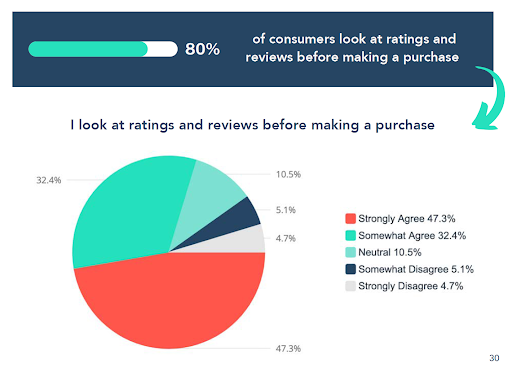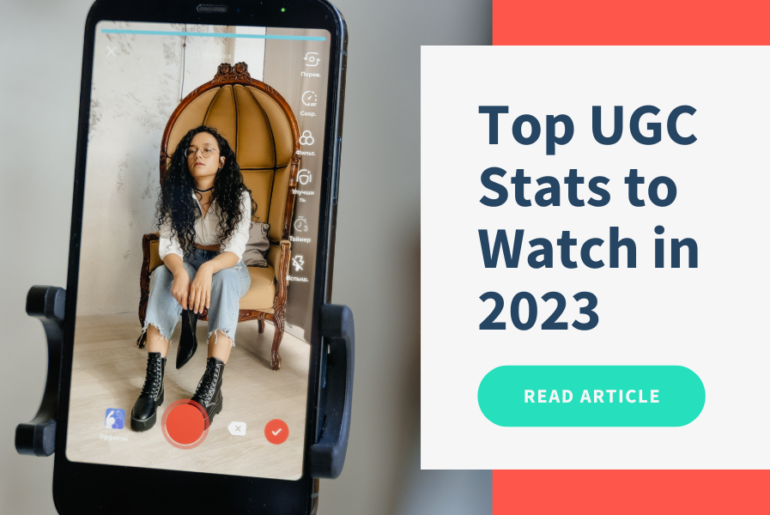Are you part of the 80% of people who check ratings and reviews before making a purchase? Consider your own buying behavior. After ensuring that a product or service is up to your specification, you likely look for authentic ratings and reviews like testimonials and photos.
People prioritize other people’s opinions before making a purchase.
And these people don’t have to be friends or family members. People trust ratings and reviews from strangers and base their buying decisions and brand sentiment around them.
In 2023, the trust consumers have for ratings and reviews is only increasing. Our 2023 State of User-Generated Content Report found that buyers want to see authentic reviews.
What’s an authentic rating and review? Let’s dig in.
The Statistics Behind Consumers Wanting More Ratings and Reviews
People read ratings and reviews before they buy products. Those reviews can live on the website’s product page, in the comments section of their social media platforms, or on their Google business page.
Our 2023 State of User-Generated Content Report found that 79.69% of consumers check ratings and reviews before making a purchase.

But here’s the thing– 75% of people surveyed said they were aware when they were being advertised to. When marketers use too-good-to-be-true reviews or show only 5-star reviews on their products, buyers don’t budge. There is a science to picking the best reviews to showcase.
The key is in authentic ratings and reviews that come directly from customers and are as personalized as possible to the buyer.
Marketers recognize the importance of ratings and reviews in driving conversions, with 69.08% stating that they are crucial to their strategies. Yet, they’re struggling to find the correct reviews. Marketers are hunting down reviews from their buyers instead of looking for organically posted reviews.
Only 35.75% of marketers regularly incorporate user-generated content (UGC) into their campaigns. Marketers must help buyers feel confident in their purchasing decision by leveraging ratings and reviews that speak to buyers’ objections and hesitations.
Examples of Ratings and Reviews
In the 2023 State of User-Generated Content Report, we explain, “highlighting happy customers across marketing channels saves marketers time required to create trustworthy content; it’s genuine feedback brands can not only re-share to strengthen the connection with their audience but also allows brands to understand market sentiment and iterate faster.”
What do great ratings and reviews look like? They are authentic user-generated content from your fans, audience, and customers. User-generated content is a photo, video, testimonial, comment, rating, or review. Brands leverage UGC to create ratings and reviews for their brand and specific products.
Use Your Community to Create Personalized Recommendations
Sephora’s Beauty Insider Community has over 5 million members. Inside the community, they featured user-generated content from happy customers using products they purchased from Sephora. They break down UGC by category (e.g., nails, gift ideas, fragrance) to make it easy for their buyers to find exactly what they’re looking for from precisely who they’re looking for.
Sephora’s buyers can see how an eye shadow works on someone with similar color eyes or how a skincare product works on somebody’s similarly dry skin. They can see if a highlighter is a color they like or if the latest curling iron gives the right size curl.
 These UGC reviews are precious to Sephora because it does something their campaigns can’t. It personalizes the buying experience. UGC reviews bring a level of personalization that’s almost impossible to create in marketing campaigns with a big budget. With UGC, brands like Sephora can show their customers people with the same skin tone, eye color, skin type, and hair type using specific products.
These UGC reviews are precious to Sephora because it does something their campaigns can’t. It personalizes the buying experience. UGC reviews bring a level of personalization that’s almost impossible to create in marketing campaigns with a big budget. With UGC, brands like Sephora can show their customers people with the same skin tone, eye color, skin type, and hair type using specific products.
Share Your Data with Buyers
Abercrombie and Fitch is leaning heavily into ratings and reviews as well. Instead of making their prospective buyers scroll through hundreds of reviews to see if a product is a good fit – they generate a data-driven report from their reviews and show a specialized summary of that information.
They show:
- How many total reviews
- Overall rating
- Percentage of buyers recommending the product
- Average customer ratings based on fit, appearance, comfort, and product quality.
- User-Generated photos
And below this summary, they have the entire list of reviews with personalized questions to help buyers find their size and style.
 Use Your Ratings and Reviews as Content
Use Your Ratings and Reviews as Content
If buyers like to see user-generated content more than brand-created content, does it make sense to fill your marketing channels with only brand content?
Based on the consumer trends we’ve watched for the last 4 years, our 2023 State of User-Generated Content Report points to the importance of highlighting UGC across marketing channels.
Brands should post UGC to their in-person and online channels as a form of content.
- Brands like Nike use digital signage in their stores to feature UGC.
- Conferences and events share a digital wall of incoming UGC content to promote more UGC (and promotion of their event!).
- Airlines like Delta share UGC on their in-flight pamphlets.
- Hotels like Marriot repost UGC from happy customers on their Instagram accounts.
- Restaurants like Chipotle dedicate their entire TikTok feed to UGC.
UGC fills in-person and online marketing channels at a lower cost than average campaign production. And it does all of this while getting more engagement and conversions than brand-created content.
6 Other Trends Shaping Marketing in 2023
Ratings and reviews are coming into maturity in 2023. We’re seeing more brands lean into giving buyers what they want and, in turn, hosting communities, sharing their review data, and prioritizing sharing UGC.
The maturation (and continued rise) of ratings and reviews is only 1 out of 6 marketing themes we discovered in our research.
Download a free copy of the State of Social & User-Generated Content Report to see the seven themes that will define marketing in 2023.




